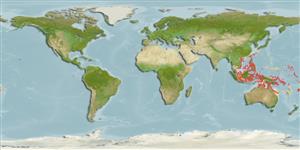Common names from other countries
Teleostei (teleosts) >
Gobiiformes (Gobies) >
Gobiidae (Gobies) > Gobiinae
Etymology: Valenciennea: From Achille Valenciennes 1794-1865; he worked with Duméril, Cuvier and Lacepède since 1815; malacologist, author of a "Histoire naturelle des poissons" (Ref. 45335).
More on authors: Hoese & Larson.
Issue
Type locality: Solomon Islands, Guadalcanal, Honiara.
Environment: milieu / climate zone / depth range / distribution range
Ecology
Marine; brackish; reef-associated; depth range 8 - 30 m (Ref. 48637). Tropical
Western Pacific: Ryukyu Islands, Philippines, Solomon Islands, Malaysia, Palau, Indonesia and the Great Barrier Reef.
Size / Weight / Age
Maturity: Lm ? range ? - ? cm
Max length : 16.0 cm SL male/unsexed; (Ref. 48637)
Dorsal spines (total): 6 - 7; Dorsal soft rays (total): 16 - 18; Anal spines: 1; Anal soft rays: 16 - 18. Characterized by pale grey body color with red and blue-edged blue-green stripe below eye; faint orange stripe along lower side; third dorsal spine longest and prolonged in adult; rhomboid caudal fin, longer than head; longitudinal scale series 76-81; ctenoid body scales, becoming cycloid below first dorsal fin; head or midline of nape without scales; side of nape with scales extending forward to above middle of operculum; fully scaled pectoral fin base and prepelvic area in adult; depth of body 5.0-5.9 in SL (Ref. 90102).
Inhabits coastal estuaries and muddy slopes adjacent to algal reef to about 30 meters depth (Ref. 48637). Solitary (Ref. 90102). Found in mud or fine silty sand bottoms, usually in the vicinity of its burrow.
Life cycle and mating behavior
Maturities | Reproduction | Spawnings | Egg(s) | Fecundities | Larvae
Hoese, D.F. and H.K. Larson, 1994. Revision of the Indo-Pacific gobiid fish genus Valenciennea, with descriptions of seven new species. Indo-Pac. Fish. (23):71 p. (Ref. 8527)
IUCN Red List Status (Ref. 130435)
CITES (Ref. 128078)
Not Evaluated
Threat to humans
Harmless
Human uses
Tools
Special reports
Download XML
Internet sources
Estimates based on models
Preferred temperature (Ref.
115969): 25.9 - 29, mean 28.2 (based on 358 cells).
Phylogenetic diversity index (Ref.
82804): PD
50 = 0.5000 [Uniqueness, from 0.5 = low to 2.0 = high].
Bayesian length-weight: a=0.01023 (0.00477 - 0.02194), b=3.02 (2.84 - 3.20), in cm Total Length, based on LWR estimates for this (Sub)family-body shape (Ref.
93245).
Trophic level (Ref.
69278): 3.2 ±0.3 se; based on size and trophs of closest relatives
Resilience (Ref.
120179): Medium, minimum population doubling time 1.4 - 4.4 years (Preliminary K or Fecundity.).
Fishing Vulnerability (Ref.
59153): Low vulnerability (10 of 100).
